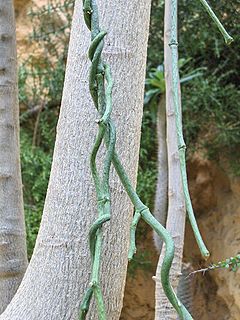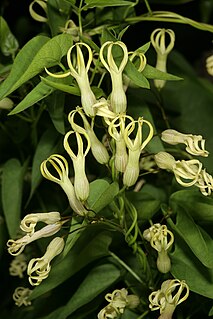
Cynanchum is a genus of about 300 species including some swallowworts, belonging to the family Apocynaceae. The taxon name comes from Greek kynos and anchein, hence the common name for several species is dog-strangling vine. Most species are non-succulent climbers or twiners. There is some evidence of toxicity.

Pergularia is a genus of the botanical family Apocynaceae. Pergularia daemia is a perennial twinning herb that grows along the roadsides of India and tropical and subtropical regions in South Asia, Africa, and Australia.
Dischidia is a genus of plants in the family Apocynaceae. They are epiphytes native to tropical areas of China, India and most areas of Indo-China. Dischidia are closely aligned with the sister genus Hoya. Unlike Hoya, the genus Dischidia is poorly known and has not been studied as closely. A few of the species in widespread cultivation, and can be kept as houseplants in temperate regions.

Aneilema is a genus of monocotyledonous plants of approximately 60 species. The vast majority of the species are native to sub-Saharan Africa, but a few are found in Oceania and one, Aneilema brasiliense, is from South America. It is the third largest genus in the family Commelinaceae after Commelina and Tradescantia, and it is one of only six genera in the family to occur in both the Eastern Hemisphere and the Western Hemisphere.

Vangueria is a genus of flowering plants in the family Rubiaceae. The genus is named for Voa vanguer, as V. madagascariensis is known in Malagasy.

Cryptolepis is a plant genus in the family Apocynaceae. It includes some 42 species.
Gongronema is a genus of plants first described as a genus in 1844. Some of the species are native to Africa, with others in South and Southeast Asia.
Tenaris is a genus of plant in family Apocynaceae, first described as a genus in 1838. It is native to southern Africa.
- Tenaris brownianaS. Moore - Angola
- Tenaris chloranthaSchltr. - South Africa
- Tenaris filifolia(Schltr.) N.E. Br. - South Africa
- Tenaris schultzei(Schltr.) E. Phillips - Kalahari Desert
- Tenaris rubella, syn of Brachystelma rubellum
- Tenaris simulans, syn of Brachystelma rubellum
- Tenaris subaphylla, syn of Caralluma edulis

Stenostelma is a genus of plants in the family Apocynaceae, first described as a genus in 1894. It is native to South Africa.
- Stenostelma capenseSchltr. - Northern Cape Province
- Stenostelma carinatum(Schltr.) Bullock - KwaZulu-Natal
- Stenostelma corniculatum(E. Mey.) Bullock - Eastern Cape Province
- Stenostelma umbelluliferum(Schltr.) Bester & Nicholas - Gauteng Province
Aspidoglossum is a genus of plants in the family Apocynaceae, first described as a genus in 1838. It is native to Africa.
Glossostelma is a plant genus in the family Apocynaceae, first described as a genus in 1895. It is native to Africa.
- Glossostelma angolenseSchltr. - Angola
- Glossostelma brevilobumGoyder - Zaïre, Burundi, Tanzania, Malawi
- Glossostelma cabrae(De Wild.) Goyder - Zaïre
- Glossostelma carsonii(N.E.Br.) Bullock - Gabon
- Glossostelma ceciliae(N.E.Br.) Goyder - Zimbabwe, Mozambique
- Glossostelma erectum(De Wild.) Goyder - Zaïre
- Glossostelma lisianthoides(Decne.) Bullock - Angola
- Glossostelma mbisienseGoyder - Tanzania
- Glossostelma nyikenseGoyder - Malawi, Zambia
- Glossostelma rusapenseGoyder - Zimbabwe
- Glossostelma spathulatum(K.Schum.) Bullock - Angola
- Glossostelma xysmalobioides(S.Moore) Bullock - Angola

Pachycarpus is a genus of plants in the family Apocynaceae, first described in 1838. It is native to Africa.

Riocreuxia is a plant genus in the family Apocynaceae, and named in honour of the botanical illustrator Alfred Riocreux (1820-1912). It was first described as a genus in 1844 and is native to Africa.

Pentarrhinum is a genus of plants in the family Apocynaceae, first described as a genus in 1838. It is native to Africa.
- Pentarrhinum abyssinicumDecne. - E + C + S Africa
- Pentarrhinum balense(Liede) Liede - Ethiopia
- Pentarrhinum coriaceumSchltr. - KwaZulu-Natal
- Pentarrhinum gonoloboides(Schltr.) Liede - Tanzania
- Pentarrhinum insipidumE.Mey. - South Africa
- Pentarrhinum ledermannii(Schltr.) Goyder & Liede - Burundi
- Pentarrhinum somaliense(N.E. Br.) Liede - Somalia

Tacazzea is a genus of plants in the family Apocynaceae, first described in 1890. It is native to Africa.

Raphionacme is a plant genus in the family Apocynaceae, first described as a genus in 1842. The genus is found primarily in Africa, with one species on the Arabian Peninsula.

Sisyranthus is a group of plants in the family Apocynaceae first described as a genus in 1838. It is native to southern Africa.
Sphaerocodon is a genus of plants in the Apocynaceae first described as a genus in 1876. It is native to southern Africa.
- Sphaerocodon acutifoliumK.Schum. - Namibia
- Sphaerocodon angolensisS.Moore - Angola
- Sphaerocodon caffrum(Meisn.) Schltr. - Tanzania, Malawi, Zambia
- Sphaerocodon melananthum(K.Schum.) N.E.Br. - Zimbabwe
- Sphaerocodon natalenseBenth. - KwaZulu-Natal
- Sphaerocodon obtusifoliumBenth. - South Africa
- Sphaerocodon platypodumK.Schum. - Katanga in southern Zaire












